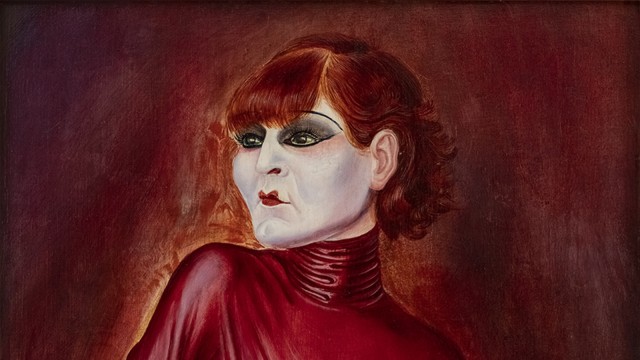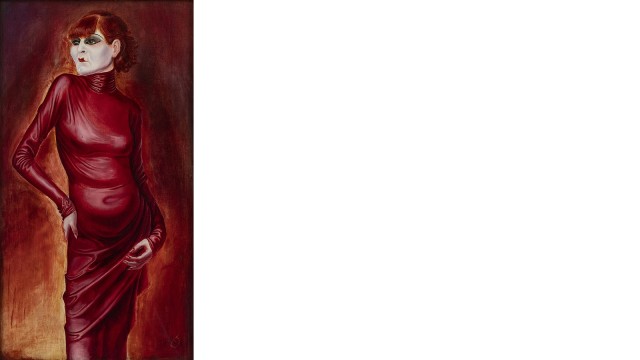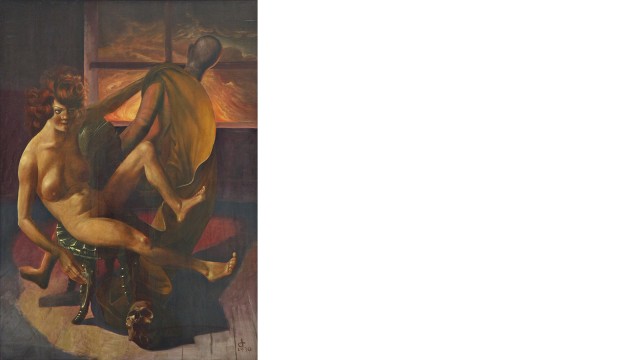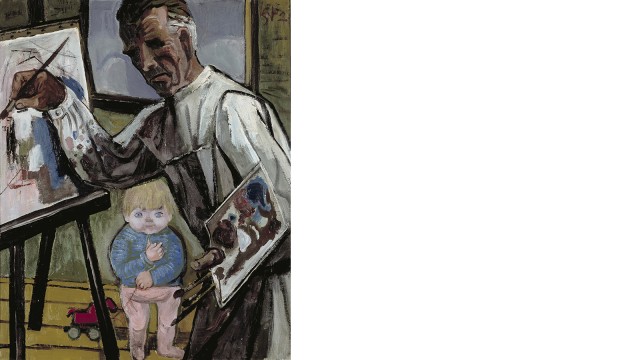
Works in the Collection
In 1919, Otto Dix returned to Dresden from the fronts of the First World War after four years’ military service. Having started his studies at the school of applied arts before the war, he continued them under Otto Gussmann at the Dresden art academy, specializing in decorative painting. Along with Düsseldorf and Berlin, Dresden would remain one of Dix’s main places of activity. Since before the turn of the century, the city had been a center of the contemporary art scene, boasting two prominent, nationally renowned locations in Ernst Arnold’s gallery and Emil Richter's “Kunstsalon”, as well as having outstanding connections to the German art hubs of Berlin, Munich, and Düsseldorf. The exhibitions at the gallery and “Kunstsalon” introduced the people of Dresden to Impressionism, Neo-Impressionism, Expressionism, the painters of the Vienna Secession, Vincent van Gogh, Dadaists, Futurists, and Cubists as well as Pablo Picasso. In 1919, Dix, Conrad Felixmüller, Hugo Zehder, Elfriede Lohse-Wächtler, and others founded the "Dresdner Sezession. Gruppe 19" in conjunction with the art critic Will Grohmann, and their first exhibition was held in the same year at Emil Richter’s “Kunstsalon”. The group was generally understood as the second generation of German Expressionism, and also received significant support from the director of the municipal art collections, Paul Ferdinand Schmidt. Consequently, at barely 30 years of age, Dix had arrived on the art scene with an awareness of all the modern art forms of his day. His works, which he produced in the early 1920s, are also referred to in art history as "Krüppel-Bilder", as Dix focused mainly on themes relating to the immediate post-war situation: disabled veterans, deformed and maimed bodies with prosthetic limbs feature in the pictures, which Dix located on the street and in back rooms in a grotesque and set-piece manner. In addition to the crippled figures, there were brothel and boudoir scenes, which laid the foundation of the lives of prostitutes becoming a key theme of Dix’s entire oeuvre.
Otto Dix came to Düsseldorf through the intervention of his fellow artist Conrad Felixmüller, who was in contact with the artists’ association "Das Junge Rheinland" and featured in the "Graphisches Kabinett von Berg & Co.”. One key figure in "Das Junge Rheinland" was Johanna Ey, whose patisserie and coffee shop near the Düsseldorf Academy was initially a meeting place for the students and artists’ groups. From 1917, she ran her own gallery, "Neue Kunst – Frau Ey". Along with Dr. & Mrs. Koch, the couple behind the "Graphisches Kabinett", Johanna Ey was also one of the first people to sell Dix’s artworks in the Rhineland. Johanna Ey went on to become one of Dix's biggest patrons. Dix also received a commission for a portrait of Dr. Hans Koch. He painted further portraits in his Düsseldorf period from 1922 to 1925, either as commissioned works or of his own volition. "Bildnis der Tänzerin Anita Berber” (1925) also ranks among this personal gallery of multifaceted contemporaries whom Dix chose to paint for himself.

Anita Berber, who began her career as a dancer in Berlin during the First World War and appeared in numerous film productions from 1918 onwards, was 26 years old when the portrait was painted in 1925. She was already a high-profile figure with a highly checkered reputation, and a magnet for scandal. This was partly due to her expressive stage routines, such as the “Tänze des Lasters, des Grauens und der Ekstase” (Dances of Vice, Horror, and Ecstasy). Furthermore, her private life was characterized by uninhibited self-expression as the very first femme fatale in a tuxedo, as well as addictions to drugs and alcohol. Dix, who was accused of obscenity and immorality in the early 1920s following exhibitions of his brothel scenes and caused further outrage in 1923 by unveiling the large, horrifying war painting “Schützengraben" at the Wallraf-Richartz Museum in Cologne, got to know Anita Berber during one of her performances in Düsseldorf. With no further attributes, he portrayed the dancer almost entirely in shades of red from garishly bright to blackened dark that blend into each other across the surface of the painting. The figure and the background are partially separated from each other by a yellowish aura. In addition, the body, face, and hair are clearly fleshed out in contrast with the background. The old master technique of glazing with oil and tempera on wood applied by Dix in this portrait, which requires a preliminary sketch on cardboard, enabled him to do the well-defined outline of the make-up on her face, portray the claw-like hand, paint the body as if it had been chiseled out of the background, and illuminate the entire picture from within. With this work, Dix again succeeded in positioning himself technically and stylistically as the inventor of "Neue Sachlichkeit", as well as an infamous chronicler of his age.

In 1926, having now moved to Berlin, Dix achieved the distinction of a professorship at the Dresden Art Academy. The artist created two of his key works here: the triptychs "Großstadt” in 1928/1929 and "Der Krieg" in 1929-1932. The work "Melancholie” dates from 1930 and thus between these two major works. It depicts a studio scene that – taken together with "Der Lustmörder (Selbstbildnis)" of 1920, the works "Selbstbildnis mit Muse” (1924), and "Stillleben im Atelier" (1924) – turn the spotlight on the painter, his work environment, and his self-image. In these portraits, the artist both depicts and is depicted. Or, as in "Stillleben im Atelier" and "Melancholie”, he has become the mere observer of his creative workplace. There, as shown in “Melancholie”, a curly-haired female nude figure on a chair with a shell-shaped backrest and a doll-like marionette viewed from the back form a mysterious pair in the night-time studio scene, framed by a wall with a large window. A yellowish-red light illumines the room behind the window, giving the impression of a world in flames. As a vanitas symbol, the skull at the nude figure’s feet emphasizes the depiction of a threatening situation, one that is perhaps staggering towards demise, but is counteracted by the lively mobility of the female body as well as the undaunted look on the nude woman’s face. Following the tradition of the old masters, in this painting Dix could be understood as a modern interpreter of melancholy as madness.
Otto Dix depicted himself in numerous self-portraits, thus constantly reflecting and defining himself in the role of artist over the decades of his creative career. He is sex murderer and dandy, craftsman, analyst, and creator. His "Selbstporträt an der Staffelei mit Enkelin" (1952) shows him at the easel in a smock with his palette. He places his granddaughter Bettina at the bottom center of the picture. By this time, Dix had moved away from the protracted glazing technique, and was now using oil-based paints wet-on-wet, applying them directly to the canvas with bold strokes. The work was painted in the German post-war period. To Dix, this meant life in a divided Germany and two different worlds. After all, in the perception of his thematically driven work, always committed to figurative representation, he was also caught between the opposing sides in the debates on culture and art in the East and the West. Although Dix was initially feted in the GDR for his realism, from the 1950s onwards he no longer met the criteria of the East German art doctrine, which allowed only art that followed the tenets of “socialist realism” in the course of the formalism debate. By contrast, appreciation of abstract art whose “absence of subject matter” embodied a liberal Western and progressive understanding of art was promoted in West Germany. Therefore, abstraction and figuration were also culturally charged terms, with the result that Dix was neither representative of the West nor the East German perspectives. In "Selbstbildnis an der Staffelei mit Enkelin", in light of the prevailing situation, he portrays himself as a realist who paints on the canvas in such an abstract way that the situation is reflected in the painter’s splotchy palette. The subversive message suggests that for Dix, abstraction is not picture material to be taken seriously.

Biography
Otto Dix (1891–1969): Born in Gera; Dix grew up in an art-loving working-class household. 1905 to 1909 Trains as a decorative painter. 1910 to 1914 Studies at the Königlich-Sächsische Kunstgewerbeschule with a scholarship from the Prince of Reuss. 1914 to 1918 Military service. Dix produces around 600 works on paper in this period. 1919 Returns to Dresden, 1919 to 1922 Studies at the Akademie der Bildenden Künste Dresden. Founds the group "Dresdner Sezession. Gruppe 1919" with Conrad Felixmüller and others. The group's first exhibition at Kunstsalon Emil Richter in Dresden. Contact with the Dresden Dada group and the printer Max John. 1921 Contact with the gallery owner Johanna “Mother” Ey. She publishes Dix's woodcut "Das Liebespaar" in her magazine "Das Ey" and generates first sales. 1922 Dix moves to Düsseldorf and becomes a master student at the Düsseldorf art academy. 1923 Works by Dix are included in the exhibition "Neue Sachlichkeit" at the Kunsthalle Mannheim. The paintings "Mädchen vor dem Spiegel" and "Salon II" are seized and Dix is accused of immorality. 1925 Moves to Berlin. 1926 Dix is appointed to a post at the Dresden art academy. 1927 Moves to Dresden. 1928 and 1930 Features in the Venice Biennale and exhibitions in Zurich and New York. 1931 Appointed as a member of the Preußische Akademie der Künste. 1933 As the Nazis seize power, dismissed from teaching, relocates to southern Germany, initially to Randegg Castle. From 1936 Dix lives in his own house in Hemmenhofen by Lake Constance. 1937 Dix is labeled as “degenerate”, around 260 paintings are seized from German museums, works by Dix are also displayed in the Munich exhibition "Entartete Kunst". 1946 Works by Dix are displayed in the exhibition "Allgemeine Deutsche Kunstausstellung” in Dresden. 1949 and 1950 Solo exhibitions at German institutions, appointments at the art academies in Berlin, Dresden, and Düsseldorf. 1955 Member of the Akademie der Künste/West, featured in "documenta 1". 1956 Corresponding member of the Akademie der Künste/Ost. 1957 Retrospective at the Akademie der Künste/Ost and in the Staatliche Kunstsammlungen Dresden. 1960 The first monograph by Fritz Löffler is issued. 1963 Retrospective at Kongresshalle Berlin/West. 1964 Features in "documenta 3". Dix received numerous honors and awards, including the Grand Cross of the Order of Merit of the Federal Republic of Germany in 1959, and the Alfred Lichtwark Prize of Hamburg and the Martin Andersen Nexö Prize of the GDR in 1966.
